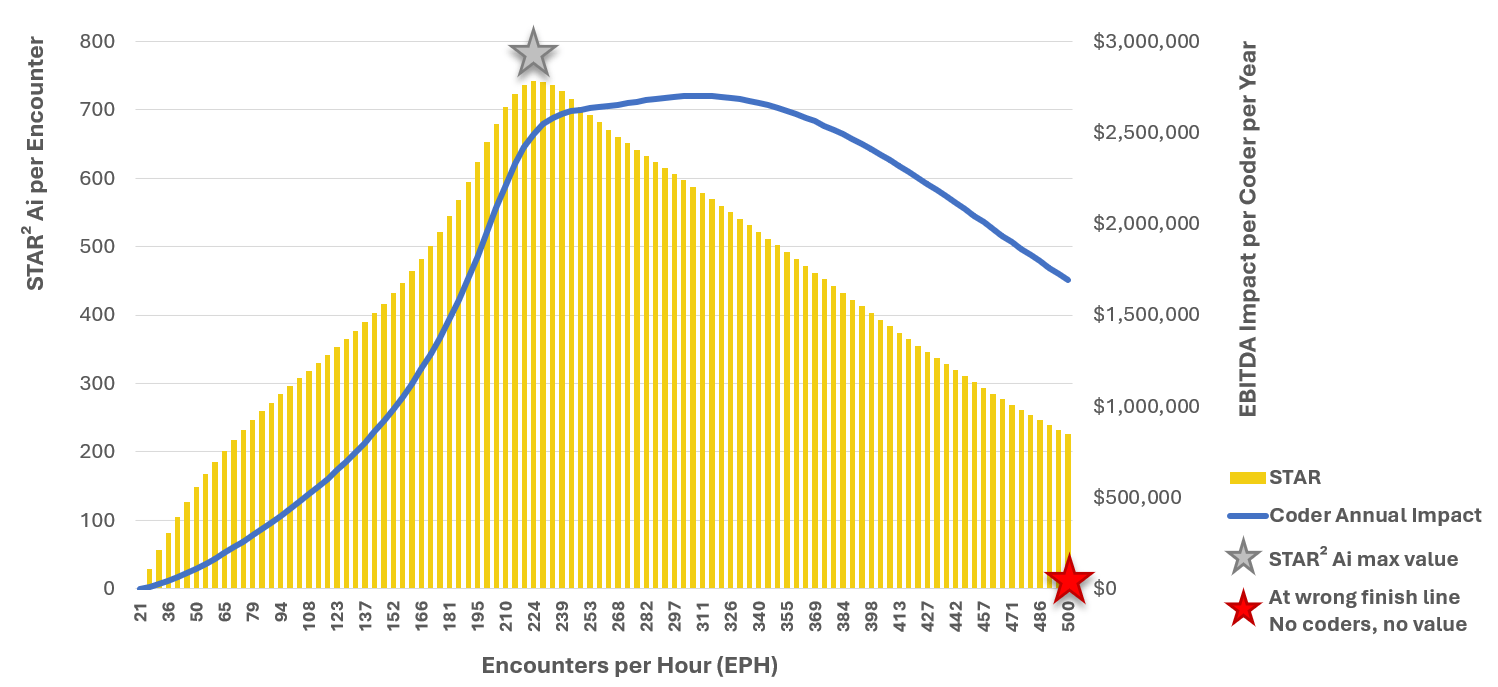How the Right AI Makes Coders $2M Superstars,
and the Wrong AI Makes Them Worth $0
The Wrong Finish Line (Part IV)

Coders are the backbone of revenue cycle success, but AI can either amplify or erase their value. With the right AI, each coder becomes a $2M per year bottom line asset. With the wrong AI, that same coder’s worth collapses to $ZERO.
STAR² Ai ensures practices scale and maximize coder impact without risking revenue, turning complexity into EBITDA gains. A STAR² Ai coder will have a higher net contribution to a practice than a physician.
If you point AI at “maximum productivity,” you eventually erase the value of a coder. If you point AI at STAR² AI’s total outcomes, you create 10× leverage and a coder who’s worth >$2M/year to the practice. The finish line you pick determines whether value accrues to payers or to physicians.
The Old Mental Model of a Necessary Cost Center with No Leverage
Consider that the average coder processes ~21 EPH (encounters per hour). An experienced coder costs $50–65k per year. In most practices, that coder is treated as a fixed cost, important, but not scalable, with their value capped at their throughput. Net contribution is roughly breakeven after salary and overhead.
That mindset is why so many groups default to chasing EPH. Speed feels like value. But speed, by itself, is a trap.
The Seduction and Trap of “Productivity-Only” AI
Everyone agrees that AI can make coders faster. Suppose you double throughput from 21 → 42 EPH. Now one FTE handles the work of two, Suddenly the same person creates real net value for the practice. So far, so good.
But keep pushing productivity as the only objective and the curve turns on you:
- If a tool’s stated goal is “infinite productivity” (full automation of coding creation), the economic value of the coder drops toward $0.
- In that world, the coder is “not needed.” You’ve optimized them out of the P&L, and you’ve optimized out the human judgment that prevents silent revenue failures, denials, and compliance risk.
This is the Wrong Finish Line. It looks brilliant on a spreadsheet and disastrous in real revenue. You move faster and straight into payer margins.
Wrong Finish Line math: As productivity approaches infinity, coder value → 0. All upside accrues to payers who underpay/deny faster than you can appeal.
The Right Finish Line Is STAR² Ai and Total Coding Outcomes
STAR² Ai measures what actually drives money to the bottom line:
- Denial prevention and avoided rework
- Charge lag reduction (cash acceleration)
- Net revenue captured (missed units, modifiers, level accuracy)
- Compliance integrity (risk avoidance)
- Productivity (EPH) as one input, not the goal
When you plot STAR² Ai on the Y-axis vs. EPH on the X-axis, the reality is unmistakable:
- The curve rises as productivity increases, up to a sweet spot.
- Past that point, STAR² Ai declines when the system outruns human oversight, denials creep in, silent underpayments grow, and total outcomes fall.
Your choice of AI determines whether you land on the peak or slide off the backside.
What the Data Show and What the Chart Means
In our internal modeling and client data:
- A coder at the sweet spot (high, but not maximal, EPH) with STAR² Ai augmentation can handle ~10× the national-average volume and prevent revenue leakage the bot would miss.
- At that apex, one coder’s incremental EBITDA impact can exceed $2M per year, every year.
- Push productivity past the peak toward “full automation,” and the EBITDA curve bends down until the coder’s value is effectively $0.

STAR² Ai Augmented Coder Impact $2M+ per Year
One finish line makes the coder a $2M asset.
The other finish line makes the coder disposable.
Why Human-In-The-Loop Wins and Keeps Winning
Payers are deploying AI to deny faster. The winning provider pattern is Augmented Intelligence:
- Edge-case judgment: Prior-authorization nuances, payer-specific rules, and documentation subtleties that change weekly.
- Adversarial adaptation: Payer AI shifts; your human-AI team must counter.
- Revenue integrity: Finding the last 1–3% of hidden value before submission, where bots are most fragile.
AI should create the first draft and surface the highest-ROI changes.
Expert coders should edit, validate, and fortify the claim—aimed at STAR² Ai outcomes.
A Simple Way to Think About the “Super Coder” Economics
Value of a coder with STAR² Ai ≈
(Incremental revenue captured per encounter + rework avoided + cash-flow acceleration) × encounters − salary/overhead
- At 21 EPH with minimal augmentation, that multiplier is small; you hover near breakeven.
- At the sweet spot with 10× throughput and higher STAR per encounter, the multiplier explodes—creating multi-million-dollar annual impact.
- At “infinite EPH,” the multiplier collapses because you removed the human signal that drives STAR.
Same FTE. Different finish line. Opposite outcomes.
What To Ask Vendors to Spot the Wrong Finish Line in Disguise
- What do you optimize for by default? Is it EPH or total outcomes (denial prevention, revenue capture, charge lag, compliance)?
- Show me your curve: Where is your productivity sweet spot and how do you keep me there?
- How do you quantify human-in-the-loop value? Where does coder judgment improve STAR per encounter?
- Payer AI countermeasures: How do you detect and adapt to changing denial behavior?
- Proof > promises: Show validated EBITDA per provider today, not theoretical “full automation” tomorrow.
If a vendor can’t answer these crisply, you’re being ushered to the Wrong Finish Line.
The Future Role of the STAR² Ai Augmented Super Coder
This isn’t a story about replacing coders. It’s a story about making the right coders invaluable:
- 10× throughput without sacrificing outcome quality
- Systematically higher STAR per encounter
- Live countermoves against payer AI
- Compliance confidence with fewer clicks for clinicians
In short, a coder is as valuable to the practice as a multi-million-dollar producer because that’s what the math says when you optimize the right finish line.
The Takeaway
- Productivity-only AI makes coders cheap, and then worthless.
- STAR² Ai optimization makes coders scarce, strategic, and enormously valuable.
- The finish line you pick today decides whether value flows to payers or physicians for the next decade.
If you want the $2M curve—not the $0 curve—aim your AI at STAR² Ai. We’ll show you exactly where your team sits on the graph and how to climb to (and hold) the peak. Let’s talk.







